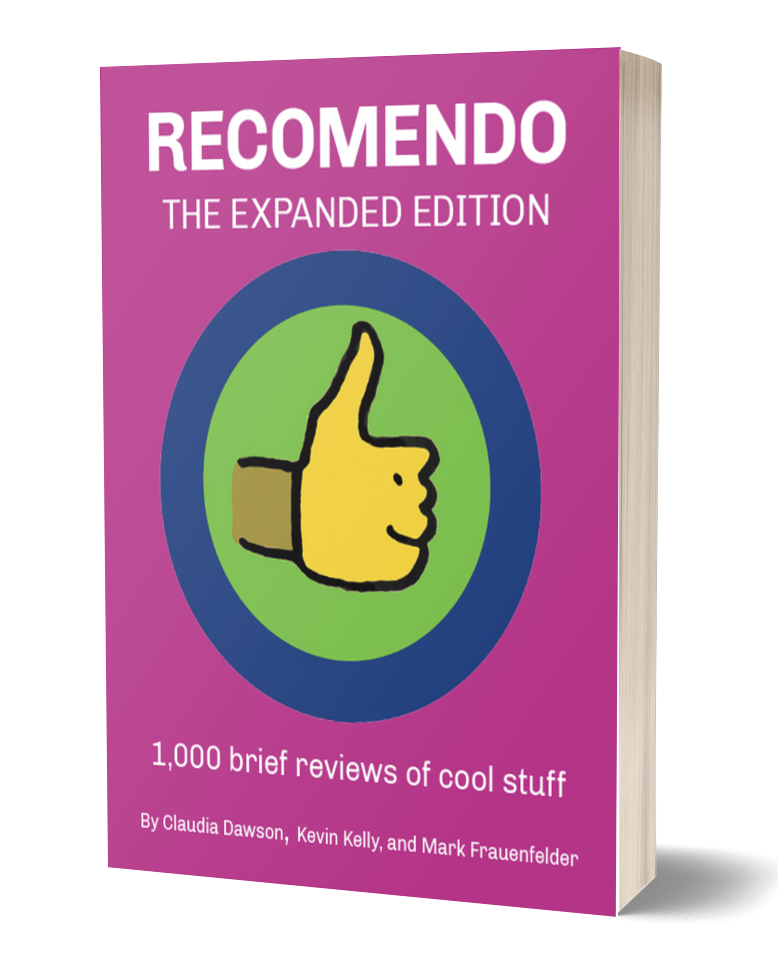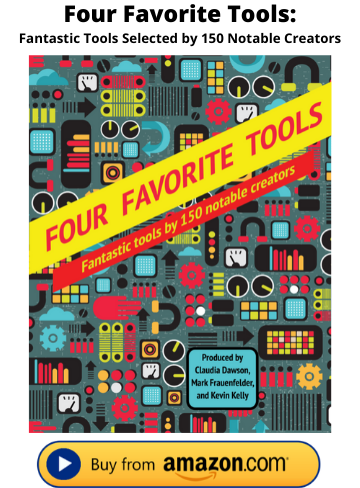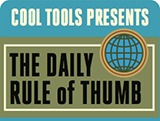20 October 2025
Dehydrators
Tools for Possibilities: issue no. 186
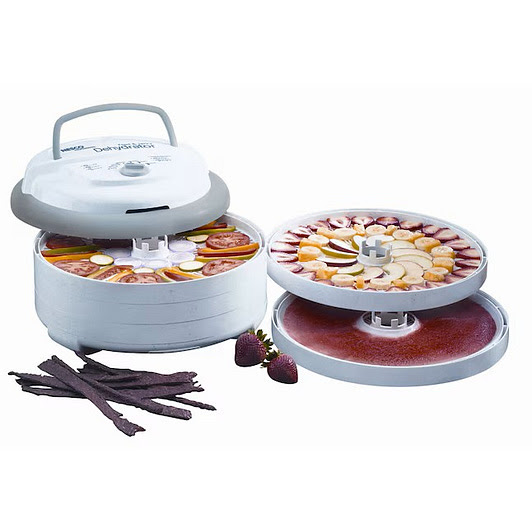
Affordable dehydrator
The Nesco Food Dehydrator is a simple, affordable, and well-built tool for drying foods quickly and thoroughly. Though not an every-day-use item for most people, it becomes absolutely essential when it is needed.
I recently went on a weekend trip hunting for morels and returned with far more than I could eat. Luckily, this dehydrator made short work of the excess. The stackable trays easily fit 60 whole small morels and many of the larger ones which I’d cut in half. Altogether, I fit about three pounds of mushrooms in fivetrays.
Like the previously reviewed Excalibur Food Dehydrator, the Nesco model has a temperature control, fan, and heating unit. The Nesco’s heating unit is built into the top (cheaper models heat bottom-up) that sits atop the stack of trays and blows air through a central column allowing for better distribution and airflow throughout.
I used a temperature of 110F when drying morels, and left them to dry over night for about 8 hours. Since any moisture can lead to a ruined batch, I made sure to let them dry out for a little longer than necessary. They were perfectly dried the next morning, and ready for storage in an airtight container.
While I have mainly used this model for mushrooms, the large trays and variable temperature dial (95-160F) allows for a wide range of dried foods to be made. This particular model is also expandable to 12 trays if you need to dry a truly astonishing amount of food.
The Nesco, when compared with the Excalibur, has the benefit of being nearly $125 dollars cheaper combined with a smaller (though expandable) footprint, a relatively-quiet fan, and similarly adjustable temperature. — JC
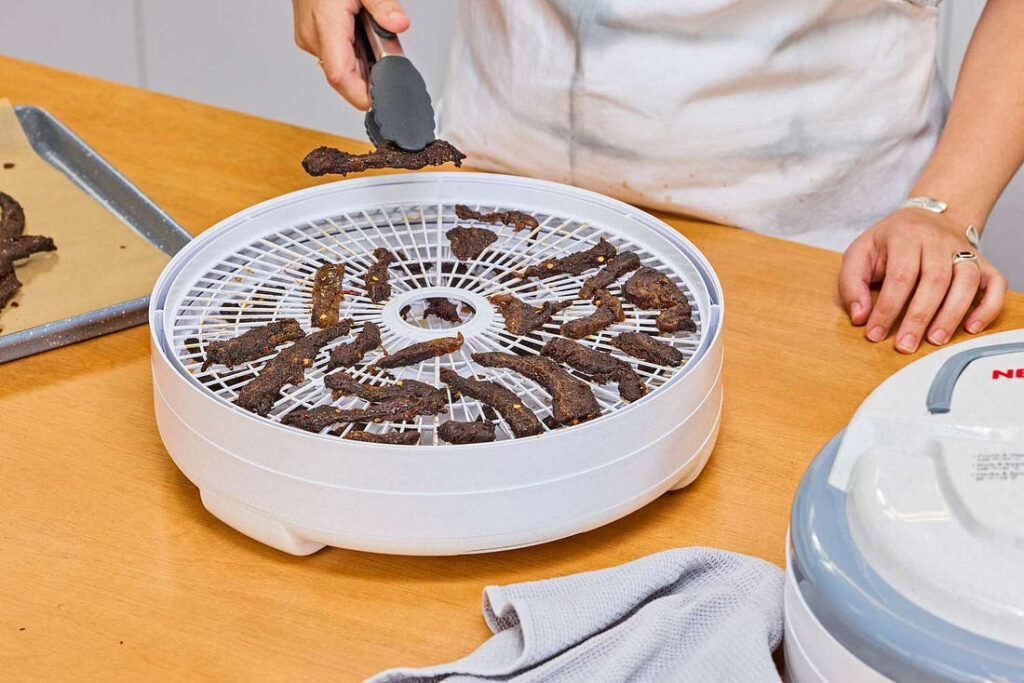
I have experience with both the Excalibur and the more recently-reviewed Nesco, a smaller and less expensive dehydrator. The Excalibur is a superior product if you are a heavy user and tend to be drying large batches of produce at once. It has quite a bit more capacity due to the design (no center hole and square racks make a big difference). The horizontal airflow system does dry large batches more uniformly. Although you can add racks to the Nesco, it dries less efficiently, and once you add in the cost of extra racks you are approaching the same price as the Excalibur.
Having said that, the price on the Nesco has really dropped and the top-down heater/blower is a nice upgrade over the older bottom-fan models. Heck, you could almost get three of them for the same price as an Excalibur, although that would take up a lot of storage space and use more energy to power 3 units. — Oliver Hulland
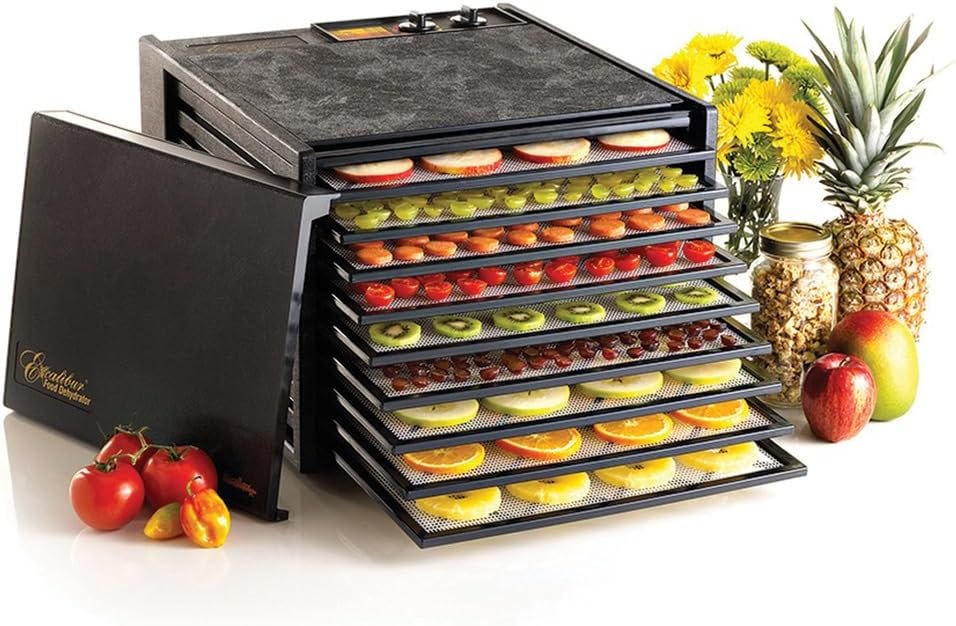
DIY dried goods
I’ve been using this 9-tray dehydrator once or twice a week for the last three years to make dried fruit, veggies, jerky, dog treats, and dried bread crumbs. Other uses include re-crisping crackers, cookies, and chips, and thoroughly drying wet photographs and flowers.
Overall, this is truly the most flexible dehydrator I’ve found. The thermostat is adjustable (85-145F), so you can customize your dehydrating. The removable trays allow you to experiment with sizes, quantities and varieties of foods sorted by temperature range. If you group shorter-term items by tray, you just remove those trays first, then keep the remaining items/trays inside a bit longer.
Other units heat unevenly from the bottom, require you to manually rotate trays, and — in the case of cheaper units — don’t let you control the temperature. Along with a thermostat, the Excalibur has a fan that distributes heat more evenly; it also features a timer, so it will automatically turn off at a desired time whether you’re around or not.
All of the dehydrators I’ve used generate noise (I now use my Ronco and Home Essentials models exclusively for making dog treats). Since the Excalibur isn’t quiet, I keep it in our craft room. It’s very easy to clean. I enjoy not throwing out spoiled food. We always have healthy snack alternatives for us and our grandkids — and they enjoy contributing to the process as much as they eating the rewards. Ever since we moved to a property with grapevines, they’ve helped us make copious amounts of raisins.
Tips:
1) To make fruit yogurt leathers or work with items high in moisture content, you’ll need ParaFlexx non-stick drying sheets. Excalibur provides a pretty good guide on how to work with different foods.
2) If you buy direct from the manufacturer, it may be slightly more expensive, but I understand they’ll guarantee the unit for 10 years; otherwise, you can purchase a 10-year extended warranty. — Chris Lewis
I have experience with both the Excalibur and the more recently-reviewed Nesco, a smaller and less expensive dehydrator. The Excalibur is a superior product if you are a heavy user and tend to be drying large batches of produce at once. It has quite a bit more capacity due to the design (no center hole and square racks make a big difference). The horizontal airflow system does dry large batches more uniformly. Although you can add racks to the Nesco, it dries less efficiently, and once you add in the cost of extra racks you are approaching the same price as the Excalibur.
Having said that, the price on the Nesco has really dropped and the top-down heater/blower is a nice upgrade over the older bottom-fan models. Heck, you could almost get three of them for the same price as an Excalibur, although that would take up a lot of storage space and use more energy to power 3 units. — JC

Affordable, freeze-dried goods
Dehydrated Food In Bulk
Backpackers, canoeists, campers and scouts have two basic ways to stock their food supply: classic prepackaged freeze-dried meals or building your own menu. Commercial freeze-dried camping food is expensive, limits menus choices and is hit or miss in the flavor department. Most of us have learned to shop carefully at the grocery store and put together a fairly lightweight, nutritious menu for weekend trips. But add a couple of people and extend the trip for two or three days and grocery store options get a bit heavy. Supplementing with bulk freeze dried or dehydrated food expands the choices and cuts down the packed weight while developing a tasty, nutritious menu without blowing the budget. If you are planning an extended trip, I highly recommend assembling your menu with these two suppliers in mind. — Clarke Green

I’ve organized six days of food for 18 people in two crews for a canoe trip (18 meals, 324 servings), which would have been impossible — or just plain expensive — had I not ordered Honeyville’s goods. They offer a wide variety of vegetables, fruits and other foodstuffs in bulk (#10 tin cans, and cases even). While a single-serving package of freeze-dried strawberries (.06 oz.) from Mountain House is $3.00 ($50.00 an ounce!), Honeyville’s #10 can of freeze-dried strawberries (6 oz.) costs just $17.00 ($2.83 an ounce). They will ship an order of any size anywhere in the continental U.S. for under five dollars — just a little more than a gallon of gas!
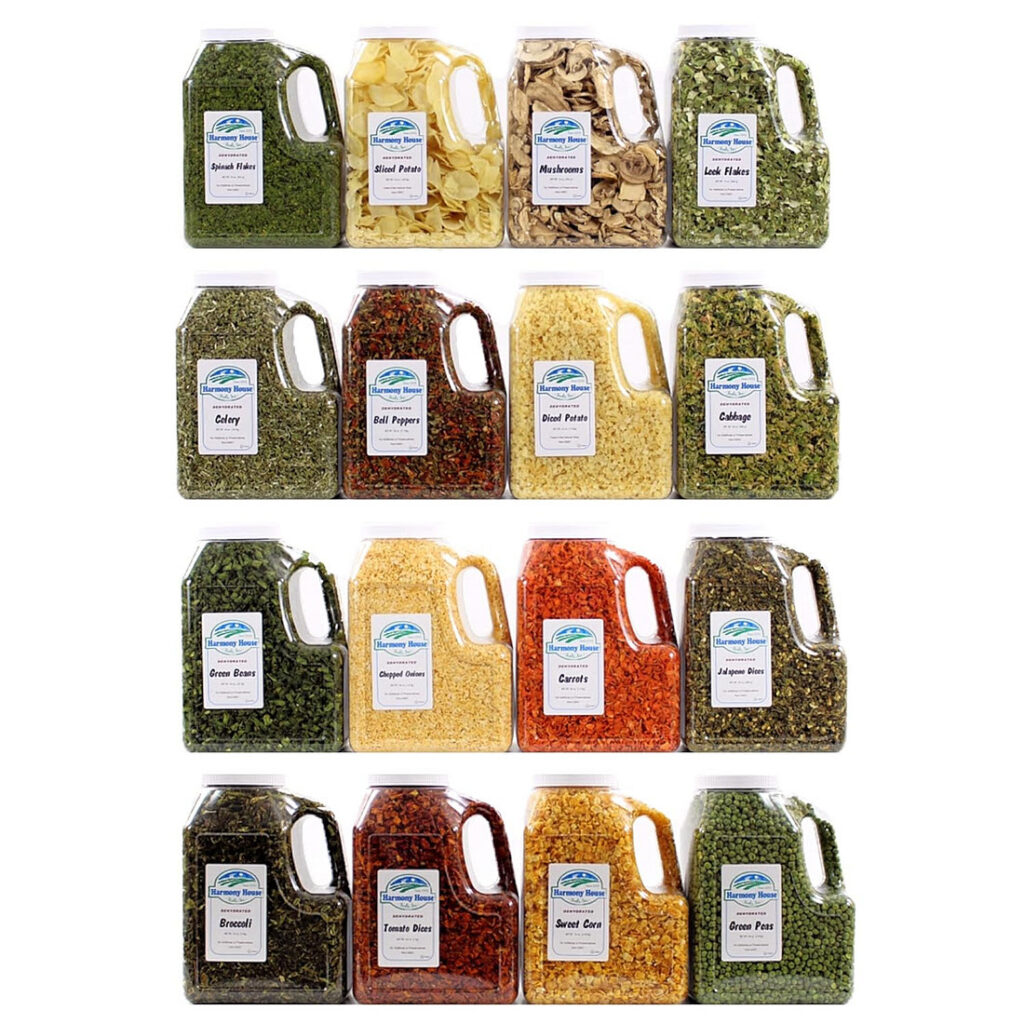
Soups, vegetables, fruits and textured vegetable protein (i.e. soy-based meat substitute) in large AND smaller quantities so you customize freeze-dried meals for long, big, short and small trips. They also offer a Backpacking Kit, a pre-selected assortment of dried foods that will make a variety of dishes. Don’t miss these two very helpful PDF files: Using Dehydrated Products and a Serving Size Chart.
Once a week we’ll send out a page from Cool Tools: A Catalog of Possibilities. The tools might be outdated or obsolete, and the links to them may or may not work. We present these vintage recommendations as is because the possibilities they inspire are new. Sign up here to get Tools for Possibilities a week early in your inbox.
10/20/2519 October 2025
Retro Recomendo: Science
Recomendo - issue #484
Our subscriber base has grown so much since we first started nine years ago, that most of you have missed all our earliest recommendations. The best of these are still valid and useful, so we’re trying out something new — Retro Recomendo. Once every 6 weeks, we’ll send out a throwback issue of evergreen recommendations focused on one theme from the past 9 years.
Quick research explainers
Two Minute Papers is a YouTube channel featuring short videos (sometimes 5 minutes long) created by a professor who reviews new research papers in visual programming, artificial intelligence, machine learning, computer graphics, simulations, and other state-of-the-art computer science. He explains the research’s significance, while running very cool graphics demo-ing the results. I find it a painless way to keep up in this fast moving field. — KK
Understanding physics
Isaac Asimov’s 768-page Understanding Physics clearly explains the principles of motion, sound, heat, light, magnetism, and electricity in a historical context. It gave me a better understanding of physics than four years of mechanical engineering school, and was actually fun to read. — MF
Collaborate with scientists
NASA has a page dedicated to their Citizen Science Projects where you can volunteer to help make scientific discoveries, like mapping bird diversity, cloud gazing, tracing patches of kelp, or identifying celestial objects in search of Planet Nine. Currently, there are 30 projects open to anyone in the world, and most can be done with just a cellphone or laptop. — CD
Best geology overview
Often science documentaries these days are fluffy with wiz-bang graphics, slick re-enactments, endless repetitions, and fancy hosts, but Doug’s Geology Journal, a series on Amazon Prime, has none of those. Doug is a regular-guy geologist who draws his own graphics with pencil, and carries his own camera as he trudges across the landscape, giving the big picture of what has happened to shape the land, and how that shapes the culture on it. He gives you the right level of details, at the exact place on the land, which makes the big picture visible. He’s my favorite geology teacher. — KK
Retro anatomy book
I have a small collection of mid-century science books for young adults, and one of my favorites is The Human Body: What It Is and How It Works. Published in 1959, this beautifully illustrated book describes how our muscular, reproductive, digestive, endocrine, respiratory, skeletal, nervous, and circulatory systems work in simple English. Out of print but inexpensive used copies are easily found online. — MF
An app to teach you about the fourth dimension
This iPhone/iPad app does just one thing — it gives you a feel for the fourth dimension by moving from 0 dimensions to 4. I’ve had this jewel of an app on my phone for years and still open it from time to time. It’s a great companion to Flatland. — MF
10/19/2516 October 2025
Stay-put Earbuds/Borderless Embassy/Growing Nomad Hotspots
Nomadico issue #175
Earbuds That Won’t Fall Out
On about half the flights I’ve been on the past few years, I see a lonely lost earbud on a seat or the floor when deplaning. I lost one myself this year the very first trip after buying them. So before a very long journey down to Patagonia I bought these Soundcore Sport X20 ones with active noise cancellation and they performed like a dream. The “sport” part refers to the fact that they go over your ear and stay snug, plus they’re waterproof, but they’re far easier to fall asleep with than headphones. The sound is amazing, especially since their app lets you fine-tune the EQ instead of blasting you with more artificially boosted bass than you asked for like many do. The battery lasted 12 hours for me and didn’t run out, so a terrific value for the current under-$60 price.
The Borderless World Embassy
For those who are in the San Francisco Bay Area in the month of October, Safety Wing is operating a pop-up salon space is open to the public in downtown San Francisco, with free coffee and co-working space for digital nomads. Every Saturday this month they will host a series of talks by remarkable speakers on efforts around the world to create the portable infrastructure and policy regime to support a modern nomadic life and borderless travel. Free tickets can be had at the Safety Wing Embassy site so you can connect with people that should probably be in your tribe. (Via Kevin Kelly).
Is Buying Points Ever Worth It?
When the whole point of travel loyalty program points is to get something extra at no cost as a reward, outright paying for those points would seem to defeat the purpose. The airline and hotel points have a defined dollar value though, based on member experience of cashing in, so sometimes when they’re offering a big promotional bonus it could be worth doing. This month I’ve gotten purchase pitches from three hotel chains. One is offering a 100% bonus above a certain threshold and the Wyndham Hotels one of +90% is intriguing because their program only has 3 tiers for redemptions. So it’s easy to do the math and figure out that you could get a $300 or $400 hotel night for $150, or you can “top off” your account to hit the redemption level for an upcoming getaway. Here are examples from AwardWallet.
Nomad Work Hubs on the Rise
Which destinations are getting more working nomads recently? This report is compiled from data based on Nomads.com club member check-ins and there are a few other statistic problems, like the year-to-year spikes/declines being averaged out. Plus percentages hide that some started at a very low base level (hello Paraguay!) Take out the volatile examples though and there’s clearly a steady uptick in Da Nang, Tirana, Hanoi, Taipei, Melbourne, Chiang Mai (still?!), and a whole lot of cities in Japan.
A weekly newsletter with four quick bites, edited by Tim Leffel, author of A Better Life for Half the Price and The World’s Cheapest Destinations. See past editions here, where your like-minded friends can subscribe and join you.
10/16/2515 October 2025
What’s in my NOW? — Alison Qiu
issue #226
Alison is a software engineer currently based in Los Angeles, California. Outside of work, she enjoys, hiking, puzzles, reading, podcasts, and learning about random facts. You can find her on Instagram @alisonqiu4 and on Goodreads.
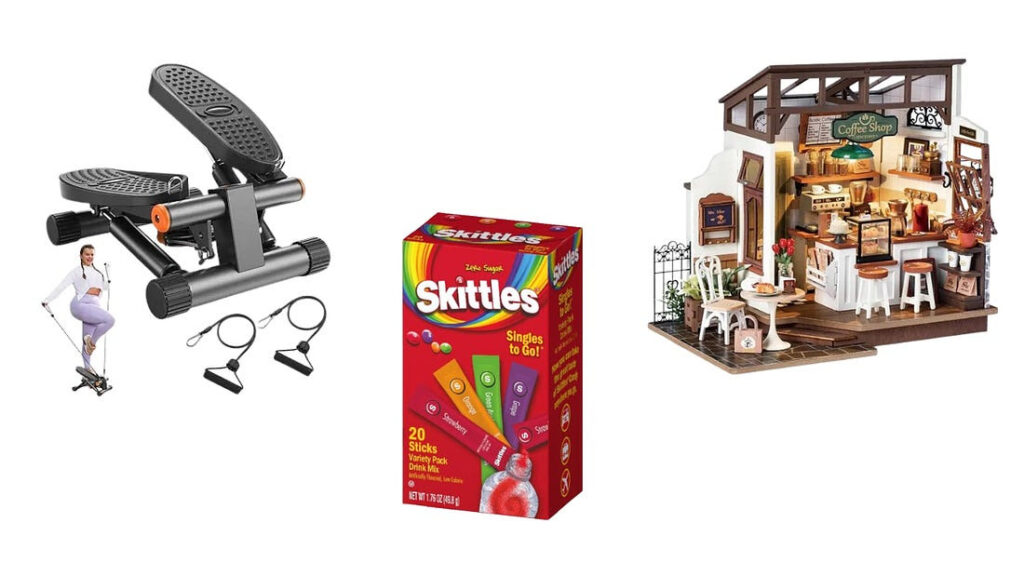
PHYSICAL
- Single to-go drink mix: I hate drinking plain water, so I was so excited when I found that for the cost of 1 store bought drink, I can make 10 bottles of beverages using these powders. They’re not only cheaper but more convenient than bottled flavored drinks. Most importantly, there are so many flavors and brands to choose from and I’ve found some surprisingly good flavors (including Skittles and Starburst)!
- Mini Stair Stepper (with Resistance Bands) for at Home workouts: As someone who works from home with a standing desk, I often get tired standing, so I love that this lets me get in extra exercise and move my leg a little bit while standing! Compared to a walking treadmill, it takes up less space and is much cheaper (the one I got was ~$50).
- DIY Miniature House Kit for Adults: This is a great date night activity if you and your partner or friend enjoy DIY projects! When I feel stressed from work, I take a few minutes to work on it. Building it is easier than I expected and more enjoyable than puzzles. When I’m done, I display it in my home, and as my collection builds up over time, I feel accomplished every time I look at them.
DIGITAL
- Nothing Much Happens Podcast: This podcast helps me fall asleep when I have a lot on my mind or I simply feel too awake. Her writing is beautiful and her voice is soothing. You don’t have to pay attention to every sentence to follow the story (which is what happens when I’m half asleep), but when I do listen here and there, her words help me imagine myself in a different environment, whether a rainy garden or a cozy house in the woods. In that calming state, I usually fall asleep before the episode ends.
- Sonia: AI Voice Therapy: Not sure if there’s an Android app, but I found this free app on my iPhone and I’ve been using it as my therapist to talk through things I have on my mind or secrets I don’t feel comfortable sharing in person. The AI voice sounds compassionate and human-like and you almost can’t tell it’s an AI. I find it works almost as well as a real therapist for helping me talk through problems or learn more about myself. Sometimes it’s also nice to have a non-judgmental listener to share secrets with.
INVISIBLE
Everyone has something to teach you. Learn from whomever you can.
Sign up here to get What’s in my NOW? a week early in your inbox.
10/15/2514 October 2025
Donabe / We Stand on Guard
Issue No. 88
DONABE – HOT POT COOKING WITH A JAPANESE FLAVOR
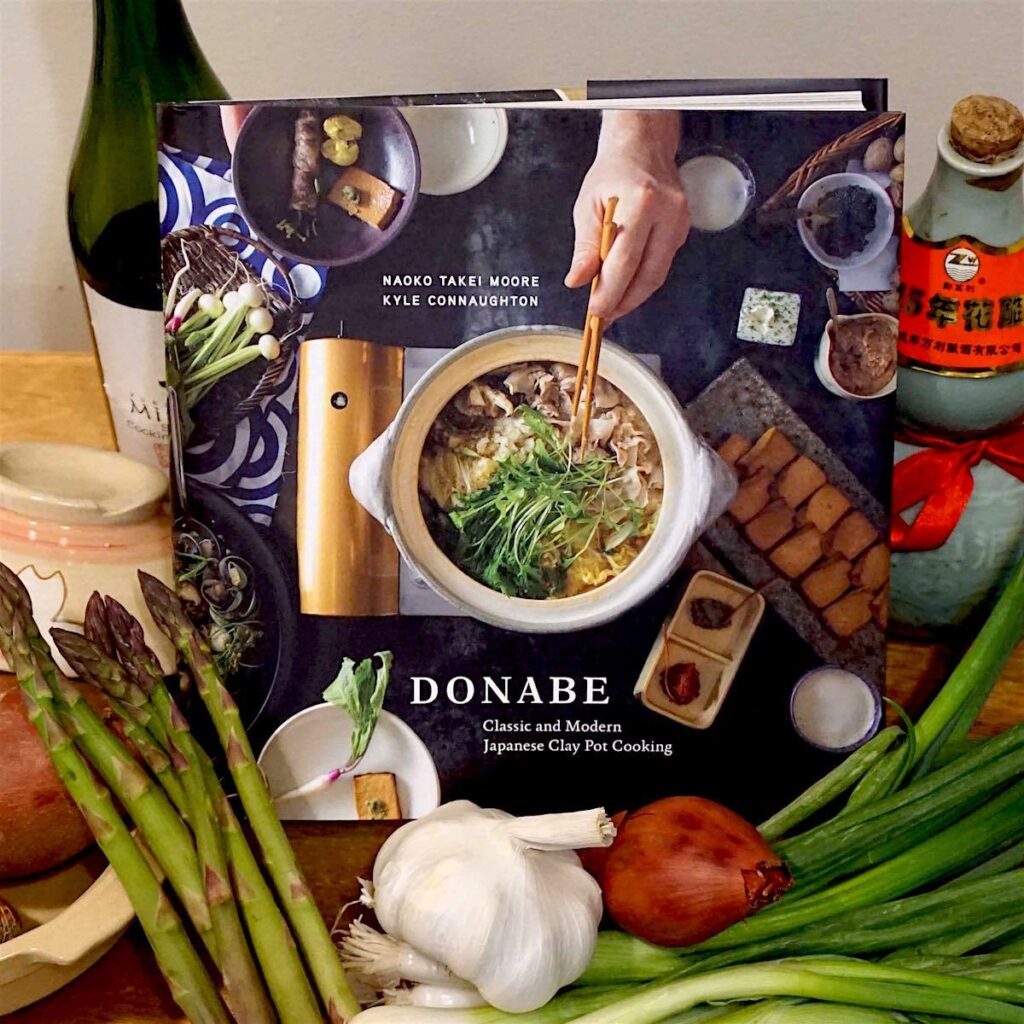
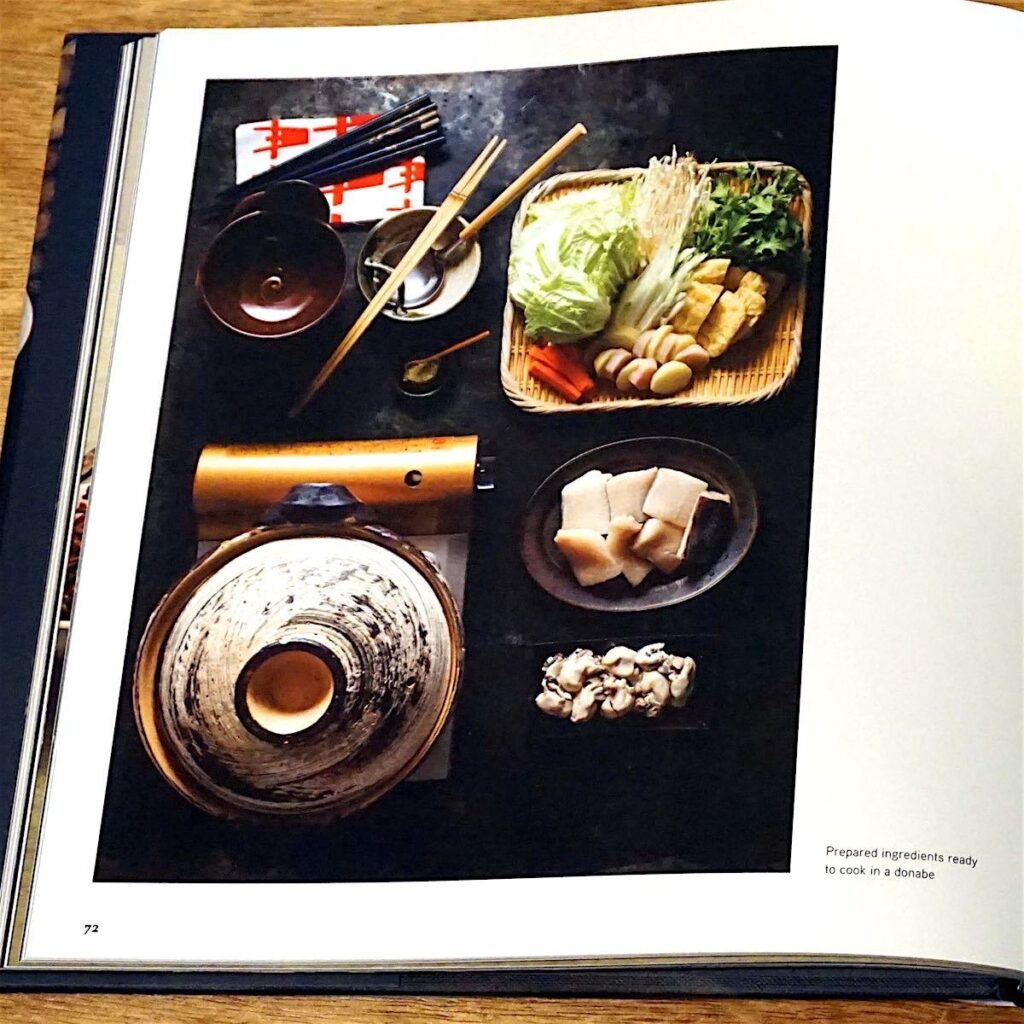
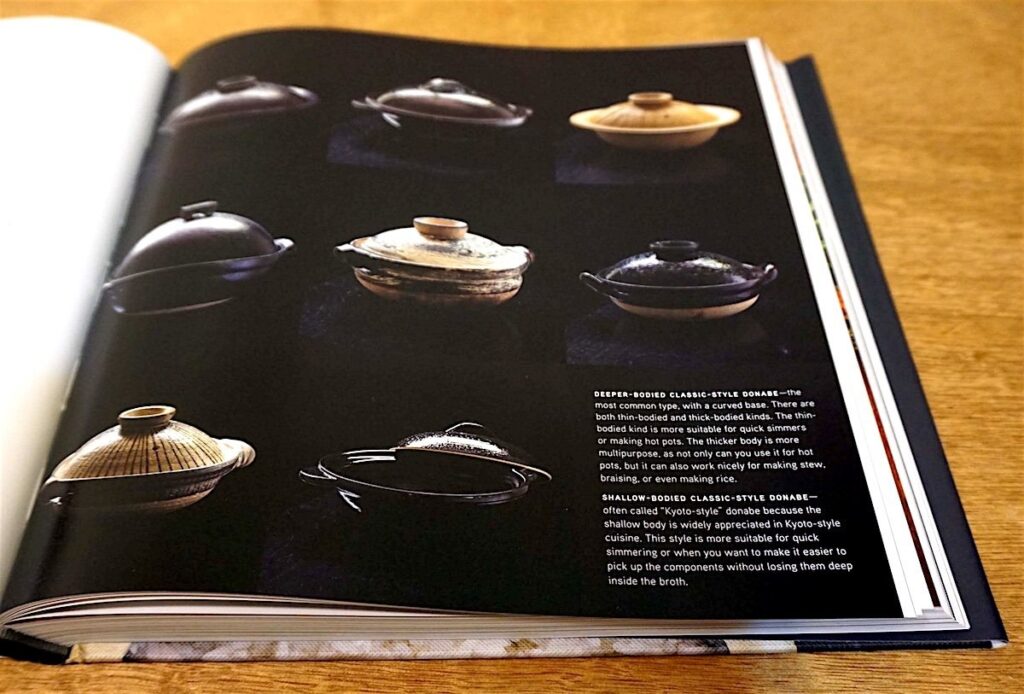


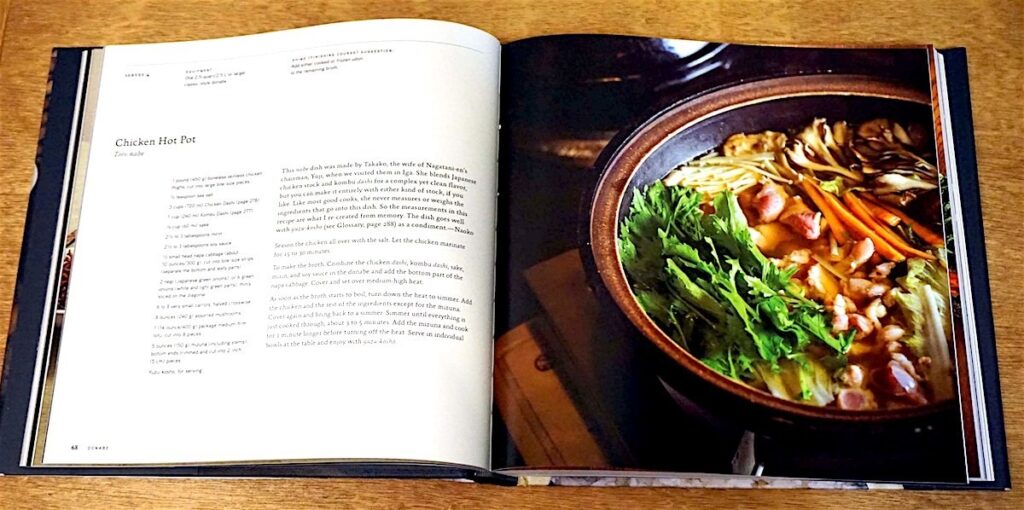


Donabe: Classic and Modern Japanese Clay Pot Cooking
by Naoko Takei Moore and Kyle Connaughton
Ten Speed Press
2015, 328 pages, 9.4 x 9.4 x 1.1 inches
Donabe (doh-nah-bei) is Japanese for clay pot. It is traditional Japanese earthen cookware and its popularity has waxed and waned with the centuries. Today donabe cooking is a family (and friends) activity, bringing people closer together with communal dining. The book features traditional as well as modern donabe recipes created by the authors and takes readers through the history, manufacture and culture of the donabe.
The authors Takei-Moore and Connaughton create an intimate communal experience with the narrative and sharing of stories. Each recipe begins with a bit of an anecdote, such as “I’ve been making this dish for years, and it’s also one of the most popular rice dishes in my cooking class.” Then the instructions follow with tips and reminders, and include serving suggestions. We can almost hear Ms. Takei-Moore gently instructing her students, “Using a paring knife, score the skin of the duck breast … Be careful not to penetrate the meat.”
Aspiring donabe chefs need not think they have to acquire many different donabe (although that might be fun!). The authors encourage experimentation and provide instructions for using a classic donabe or even a dutch oven if you do not have the type of donabe specified. The book itself is a delightfully sumptuous eyeful with beautiful photographs of different donabe, ingredients and finished dishes. Sturdily constructed with heavy glossy pages that are sewn in, the book falls open flat just like you’d want a cook book to.
Donabe is delightful reading and the recipes are authentic, delicious and most are not complicated or difficult for the beginner to make. I loved reading and leafing through the book, trying out the recipes and extending my knowledge of “hot pot” cooking with a Japanese flavor. Interestingly enough, until I read the book, I had not heard of shime – a recipe that uses the remaining broth of the donabe recipe if it is a soup or stew to create an end-of-the-meal dish. Don’t just drink up the broth, create yet another course! – Carolyn Koh
THE US SICS ITS ROBOT DRONE ARMY ON CANADA’S WATER SUPPLY IN WE STAND ON GUARD









We Stand on Guard
by Brian K. Vaughan (author), Steve Skroce (artist) and Matt Hollingsworth (artist)
Image Comics
2016, 160 pages, 7.3 x 11.1 x 0.6 inches (hardcover)
You know those cheeky jokes about the United States invading Canada? No one is laughing in Brian K. Vaughn’s We Stand on Guard, an extremely tense, often brutal, military sci-fi thriller with an obvious political point to make.
Some 100 years in the future, an allegedly Canadian drone strike on the White House destroys it, killing the president. The US responds with everything it’s got while Canada screams false flag attack, an excuse for the US to come after Canada’s precious water resources (which, surprise, the US is plumb out of). The US deploys its immense drone arsenals, including giant, stompy mecha robots, and “hoser ships,” aerial tankers that fly over Canada sucking up all of her water. The story in the book revolves around a group of Canadian guerilla fighters trying to repel the US occupation.
While the subject matter is intense and the pacing of the book rarely lets you catch your breath, there is levity, too. There are plenty of insider Canadian jokes, a character from Quebec whose French dialog is never translated, and an ongoing bit about Superman having Canadian roots (he was co-created by Canadian artist Joseph Shuster). And while there is plenty of action, with everything from skirmish combat to giant, all-out battlefield hellfire, this is a very dialog-driven book and a book that is chalk full of interesting speculative tech and a believable near-future world.
A country being occupied by a vastly superior high-tech military, with questionable evidence to justify its actions, and irresistable natural resources that just happen to be sorely needed by the invaders… Hmmm, where have we heard this story before? Having the enemy be Canada, not Iraq, definitely changes the way that you relate to the guerillas and your shifting allegences to who the “good guys” actually are. This hardcover edition, collecting the first six issues of the series, is beautifully produced. Besides the series, there is a sketchbook in the back showing dozens of artist Steve Skroche’s sketches and pre-colored panels. – Gareth Branwyn
BTW: I found that this book had a lot of thematic and stylistic similarities, as well as a similar level of white-knuckled ferocity, to Letter 44. If you enjoyed that series, you’ll probably want to check out We Stand on Guard.
Once a week we’ll send out a page from Cool Tools: A Catalog of Possibilities. The tools might be outdated or obsolete, and the links to them may or may not work. We present these vintage recommendations as is because the possibilities they inspire are new. Sign up here to get Tools for Possibilities a week early in your inbox.
10/14/2513 October 2025
Kayaks
Tools for Possibilities: issue no. 158

Best kit for building a Coho kayak
Using the Kayaks You Can Build book, I built my first Coho, a stich-and-glue plywood sea kayak. Before deciding on the Pygmy kit, I also considered ones offered by Mill Creek, Red Wing, Cheasapeake Light Craft, Dancing Waters, and One Ocean Design. In the end, I settled on Pygmy based on the feedback I got from other builders who touted just how very, very accurate the computer controlled router cut parts are. From the start, I realized I’ve seen a lot of Cohos out there over the years, which seemed to imply the design would be pretty well nailed down and refined by now. I was right.
The eight panels in the hull of the Coho make it a multi-chine boat, sort of half way between a strip construction and a four-panel hull. The way the deck fits elegantly onto the hull was also a big factor in my decision. I really like the fact that it is such a simple, but effective attachment. Some designs mandate you place screws or nails through the deck to the shear — to me that just seemed wrong. I also liked the more modern vertical stern, though the bow still very much keeps with a classic Greenland kayak shape. The hull is not too wide, but very stable and the deck’s extra two panels create a shape that reduces the knocking of your knuckles when you’re paddling. Also, the thinner panels of the hull really allow them to twist and create intriguing transitions that are simply not possible with a four-panel hull.
I was at Eagle Lake, CA and someone had a Pygmy Arctic Tern. The boat paddled like a dream — reminded me of the first time I rode a high quality road racing bicycle. I was finally sold. Not long after, I bought my Coho kit from Pygmy.
I took a pretty leisurely approach and probably spent about 300 hours, until it was done. After that, there is always something to consider adding — a carrying cart, some kind of a sail rig, etc. So I guess it is never really all finished! There really are only two problems with the Coho: 1) though they are very durable, you have so much time in them, you still really want to take care of them, 2) just about every trip I go on I get about six people a day stopping and asking me questions. It can actually delay your leaving the beach! — Mark Forwalter

Inflatable heavy-duty kayak
Advanced Elements Inflatable Kayak
The Advanced Expedition inflatable kayak has allowed me to get out on the water more often than I ever would with one of its hardshell cousins.
Because the boat fits in the trunk of my car and can be carried solo in a duffle bag, I find myself using it when the hassle of loading a more traditional kayak onto a roof rack and muscling it around would dissuade me. Using a double action pump it can be set up and ready to go in under 10 minutes, and the break down is even faster. It just deflates and folds back into its bag.
While it doesn’t track as well as a hard bottomed boat, it more than makes up for this with its incredible stability. Buoyed by two high-pressure inflatable tubes that form the 13.5 foot frame, the boat withstands moderate waves and can carry up to 400 pounds. Standard spray skirts fit and keep the inside snug and dry.
I have used it to surf waves, paddle with sea lions, and as a kayak escort for swim races. In all cases I have been able to keep up with fellow kayakers.
I highly recommend this for kayakers who want a full size boat but don’t have a garage or the space to keep one! — Ben Hanna

Guide to constructing Coho boats
I have built several simple fiberglass canoes and repaired my sailboats, but using this book I was able to build my first “real,” high-performance boat, a Pygmy Coho, a stitch and glue plywood construction sea kayak. I read a lot of books on kayak construction, stitch and glue type in particular. I also used the Coho building manual from Pygmy some. But I absolutely would not have been as successful with my boat had I not read this book before building and referenced it during building. The detail, sharing of practical experience, the tons of photos, clarity in explanation and the examples of the exact same boat — the Coho — made this the only choice. The book lays out everything in terms of what you can expect to accomplish on Day 1, Day 2 and so forth. Even if you don’t follow it step by step, the book provides the fundamentals to make good alternative building decisions.
I was able to do all of the following alternatives: Rigged up my own plumbing for a built in bilge pump. Added 4-oz glass to the deck for strength. Added the bulkheads to also gain rear deck strength. Doubled the coaming lip for strength and aesthetics. Added in hardwood keys at the coaming spacer joints for strength. Fiberglassed the entire coaming (probably really not necessary). Made my own jigs with hot glue and pop sickle sticks as prealignment tools for bulkheads, seat braces, deck joint, etc.
Above all else, the book explains how to build a very flat, level, elevated worktable with internal/external stations to hold the boat in position. That aspect alone is reason enough to go with this book. I am currently building a skin-on-frame, Greenland style kayak for my wife, but I would re-read this book before building any other stitch and glue boat. I also recommend the Greenland kayak website, Qajaq USA and Guillemont Kayak’s boat-building forum, where there is a wealth of information for the construction and use of stitch and glue, strip building and traditional skin-on-frame (SOF) kayaks. — Mark Fowalter
- In order to achieve professional results, each stage of your work should be completed with the least number of steps as well as prepare you for the next stage. For example, if you apply the filler casually with a stick, before the next step can happen the excess will have to be sanded off. Professionals eliminate the cleanup step by placing just enough filler in the right place to do the job. When the masking tape is peeled off, the step is complete and ready for the next one. Keeping the filler under control saves time and minimizes exposure to the bad stuff. That’s a pretty fair payoff, but there’s also a bonus that comes with thinking lazy. That bonus is professional results. You cannot build a professional-quality boat when you are doing damage control between each step… We are all good at something; by combining an understanding of what needs to be done with what is already familiar, we find that practical solutions present themselves.
- The less epoxy you put on, the less you have to sand off. If the epoxy is kept under control when wet, expect about one day of sanding, preferably outside. Tidy glue application brings the additional benefits of less unhealthy dust produced and more efficient — and less costly — use of the epoxy.
- How to Begin
So, how to begin? One option, of course, is the freeform approach, in which the kayak is built right on the floor or, as one manufacturer suggests, on somethingflat like three cardboard boxes. Although this lets you get right to work, there are a number of drawbacks. One is the possibility of introduction funky eccentricitiesand variables to a process that requires precise control. The other is the questionable practicality of spending hours bent over, toiling on the floor. Thisis a pretty good sized “some assembly required” project, and at some point in the process either your knees or your back will start protesting.
Another way to go is to build a worktable that will raise your assembly surface to a more civilized altitude. With some forethought the worktable also becomes a modification of the traditional boatbuilder’s strongback. A big advantage to the worktable is that you are, in effect, working from the same baseline that the designer used to draw the boat. With the addition of a centerline and station liners, the table becomes an accurate reference and a jig for many of the building steps… Being able to reach in and clamp along the edge of the worktable is convenient, and a step towards making tidy joints that require very littlecleanup. This not only saves time but also reduces your exposure to the epoxy. - Building the box beam and fitting and leveling the top of the worktable took the best part of one day and consumed two sheets of plywood. If building this beam sounds like too much work, there are other possibilities for getting a stable base under the top. Consider a straight ladder set up on a sawhorses, laminated floor joints or anything else that will support the length of the table to accommodate your height and the kayak you are building.
Making the long straight cuts necessary for building a straight table could be a challenge for the casual builder. The easiest solution, and one that also simplifiestransportation, is to have the plywood sheet ripped into desired widths when you purchase the board. Some big-box home improvement stores offer this service at little or no extra cost, using extremely accurate dedicated panel saws. If you decide to do it yourself and are using a table saw, keep in mind that the panel must be supported at both the in-feed and out-feed ends for safety reasons and to ensure that the cuts are straight. If you are using a portable circular saw, consider clamping a straightedge to the board to guide the saw. The simple-to-build box beam consists of two 8-foot open-ended boxes held together with a 4-foot sectionthat fits in the open ends of the boxes to tie them together. The important point to keep in mind is that once joined, the top side of the box must be straight.
Cradle forms are the secret to controlling the shape of a plywood kayak. They can make the difference between a twisted hull with a hogged bottom and the beautiful kayak in your mind. Besides, now that you have a worktable, you might as well add several cradle forms and enjoy the peaceful rhythm of building when the pieces fall into place and stay where you put them. With cradles attached to the predictable base formed by the worktable, the hull will come together at a controlled distance above the baseline and will be centered over the table centerline; our horizontal reference will be the level, anytime we need it. As flimsy plank is added to the flimsy plank, the crade forms will hold all the pieceswhere they should be. The pieces will come together without being stressed or having to be bullied into position.
Cover the path of the cut with masking tape to provide something to mark on and to protect the desk and the edge of the cut. Drill a hole inside the line big enough for the jigsaw blade (5-84). Take your time making the cut. Trust the line and follow it; it is easier to make the first cut to the line than to try to clean it up later. As the cut progresses, bridge the joint with tape to keep the cutout from falling into the hull (5-85). Peel off the tape when you have finished making the cut and clean up the shape with a rasp or a hard sanding block if needed. This opening will be the pattern for trimming the parts to come, so getting a smooth shape now will save correcting the same problem on the spacer and rim later.
Once a week we’ll send out a page from Cool Tools: A Catalog of Possibilities. The tools might be outdated or obsolete, and the links to them may or may not work. We present these vintage recommendations as is because the possibilities they inspire are new. Sign up here to get Tools for Possibilities a week early in your inbox.
10/13/25ALL REVIEWS
 10/10/25
10/10/25
Gar’s Tips & Tools – Issue #205
Access to tools, techniques, and shop tales from the diverse worlds of DIY
EDITOR'S FAVORITES
COOL TOOLS SHOW PODCAST
WHAT'S IN MY BAG?
15 October 2025

ABOUT COOL TOOLS
Cool Tools is a web site which recommends the best/cheapest tools available. Tools are defined broadly as anything that can be useful. This includes hand tools, machines, books, software, gadgets, websites, maps, and even ideas. All reviews are positive raves written by real users. We don’t bother with negative reviews because our intent is to only offer the best.
One new tool is posted each weekday. Cool Tools does NOT sell anything. The site provides prices and convenient sources for readers to purchase items.
When Amazon.com is listed as a source (which it often is because of its prices and convenience) Cool Tools receives a fractional fee from Amazon if items are purchased at Amazon on that visit. Cool Tools also earns revenue from Google ads, although we have no foreknowledge nor much control of which ads will appear.
We recently posted a short history of Cool Tools which included current stats as of April 2008. This explains both the genesis of this site, and the tools we use to operate it.









